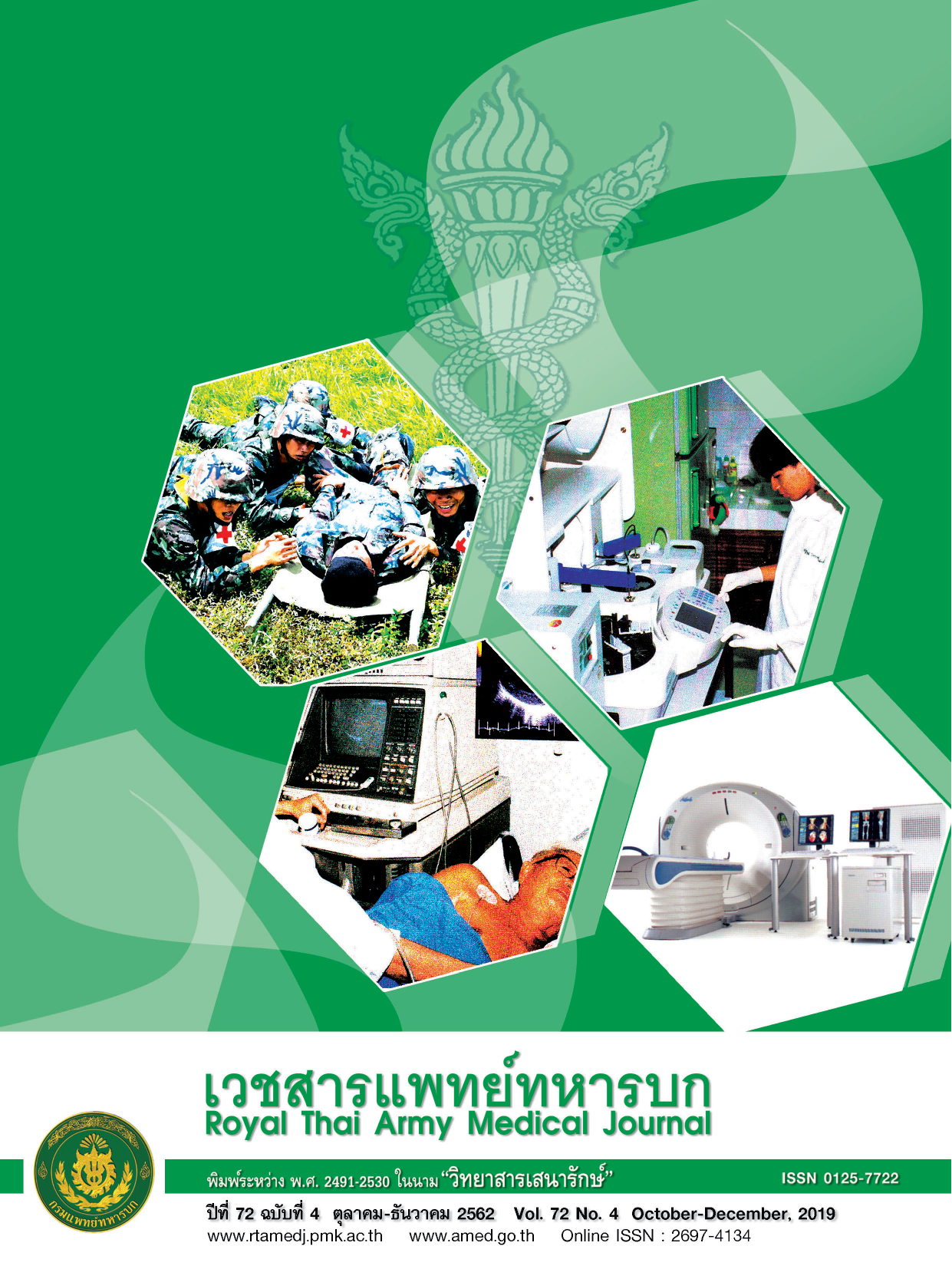Radiation Protection in Diagnostic X-ray Imaging
Main Article Content
Abstract
เครื่องมือทางรังสีวินิจฉัยมีความสำคัญและมีบทบาทเป็นอย่างมาก ในการถ่ายภาพและแสดงภาพรังสีทางการแพทย์เพื่อประกอบการแปลผลและวินิจฉัยโรคของผู้ป่วย ประกอบด้วย เครื่องมือตรวจทางรังสีวินิจฉัยที่ใช้รังสีก่อไอออน (Ionizing radiation) ได้แก่ รังสีเอกซ์ ซึ่งถูกนำมาใช้ในการตรวจเอกซเรย์ทั่วไป (General X-ray Machine) การตรวจด้วยเครื่องส่องตรวจทางรังสี (Fluoroscopy X-ray Machine) การตรวจด้วยเครื่องเอกซเรย์ระบบหลอดเลือด (Digital Subtraction Angiography) รวมทั้งตรวจด้วยเครื่องมือพิเศษ ได้แก่ เครื่องเอกซเรย์คอมพิวเตอร์ (Computed Tomography Machine) และเครื่องเอกซเรย์เต้านม (X-ray Mammography) เป็นต้น ขณะที่รังสีไม่ก่อไอออน (Non-ionizing radiation) ถูกนำมาใช้ในการตรวจด้วยเครื่องสนามแม่เหล็กไฟฟ้าและคลื่นวิทยุ (Magnetic Resonance Imaging) เป็นต้น เครื่องมือเหล่านี้เป็นเครื่องมือที่มีความสำคัญอย่างมากในงานรังสีวินิจฉัย ใช้ในการถ่ายภาพผู้ป่วยเพื่อหาพยาธิสภาพ เพื่อให้การตรวจวินิจฉัยและรักษาผู้ป่วยเป็นไปด้วยความรวดเร็ว ใช้ปริมาณรังสีให้น้อยที่สุดและก่อให้เกิดประโยชน์สูงสุด
อย่างไรก็ตาม รังสีก่อไอออน เมื่อผ่านเซลล์ของสิ่งมีชีวิต (Living cells) อาจทำให้อะตอมเกิดการแตกตัวเป็นไอออน (Ionizing) เรียกขบวนการที่ทำให้เกิดการแตกตัวเป็นไอออนว่า ไอออไนเซชั่น (Ionization) หรืออะตอมอาจถูกทำให้มีพลังงานสูงขึ้น แต่ไม่มากพอที่จะทำให้อิเล็กตรอนรอนหลุดออกจากอะตอมได้ ทำให้อิเล็กตรอนเปลี่ยนจากสถานะพื้นไปสู่สถานะถูกกระตุ้นได้ โดยไม่ได้ทำให้อิเล็กตรอนหลุดออกจากอะตอม เรียกขบวนการนี้ว่า เอกซ์ไซเทชัน (Excitation) โดยทั้ง Ionization และ Excitation ถือว่าเป็นขั้นแรกของการนำไปสู่การทำลายเซลล์ของสิ่งมีชีวิต(1)
ดังนั้นบุคลากรทางรังสีและผู้ที่เกี่ยวข้อง ควรมีความรู้และความเข้าใจเกี่ยวกับผลของรังสีต่อสิ่งมีชีวิตและการป้องกันอันตรายจากรังสีในงานรังสีวินิจฉัย เพื่อนำรังสีมาใช้ประโยชน์ในการตรวจให้กับผู้ป่วยได้อย่างมีประสิทธิภาพ และมีความปลอดภัยสูงสุด
Article Details
References
2. World Health Organization. Ionizing radiation, health effects and protective measures [Internet]. 2016 [cited 2019 Sep 28]. Available from: https://www.who.int/news-room/fact-sheets/detail/ionizing-radiation-health-effects-and-protective-measures.
3. Gordon E. 5.4:Ionizing radiation and non-ionizing radiation [Internet]. 2019 [cited 2019 Sep 30]. Available from: http://chem.libretexts.org/link?85161
4. Caer SL. Water radiolysis: influence of oxide surfaces on H2 production under ionizing radiation. Water. 2011;3(1);235-53.
5. The National Council on Radiation Protection and Measurements (NCRP) reports 116. Limitation of exposure to ionizing Radiation. Bethesda, MD: NCRP Publications; 1993.
6. The International Commission on Radiological Protection Publication 119. Compendium of dose coefficients base on ICRP publication 60. Essen: Elservier; 2012.
7. The International Commission on Radiological Protection Publication 26. Recommendations of the International Commission on Radiological Protection. Oxford: Pergamon; 1977.
8. The International Commission on Radiological Protection Publication 60. The 1990 Recommendations of the International Commission on Radiological Protection. Oxford: Pergamon; 1990.
9. The International Commission on Radiological Protection. Radiation Protection ICRP Publication 103. The 2007 Recommendations of the International Commission on Radiological Protection. Essen: Elservier; 2007.
10. Ministry of the Environment of Japan. Health Effects of Radiation. Booklet to provide Basic Information Regarding Health Effects of Radiation. Tokyo: Ministry of the Environment of Japan; 2015. p. 77-92.
11. RadiologyInfo Organization. Effective Radiation Dose in Adults [Internet]. 2019 [Cited 2019 Sep 30]. Available from: https://www.radiologyinfo.org/en/info.cfm?pg=safety-xray.
12. United States Nuclear Regulatory Commission. Radiation protection and the NRC. Washington, D.C.:U.S. Nuclear Regulatory Commission;2010. p.7-8.
13. International atomic Energy Agency. Radiation protection of the public and the environmental, general safety guide. Series: IAEA safety standards series, ISSN 1020-525X ; no.GSG-8. Vienna, Austria: IAEA;2018. p. 6-8.
14. International atomic Energy Agency. Radiation protection and safety in Medical uses of ionizing radiation. Series: IAEA safety standards series, ISSN 1020-525X ; no.SSG-46. Vienna, Austria: IAEA;2018. p. 36-9, 89-121.

